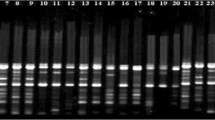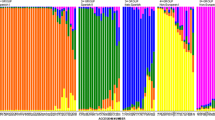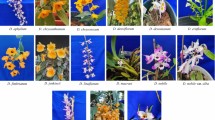Abstract
Genetic divergence was studied in selected 36 genotypes of Dalbergia sissoo Roxb. on the basis of seven morphological parameters. The divergence among genotypes was estimated by Mahalanobis method and genotypes were grouped into clusters by Tocher’s method. All the genotypes were classified into seven distinct clusters on the basis of seven morphological traits. Cluster 1 was the largest with 25 genotypes followed by Cluster 2 (four genotypes). Cluster 3, 5, 6 and 7 were the divergent clusters. The D 2 analysis revealed that D 2 value (39.42) between clone 5040 and clone 201 was recorded maximum. The intra-cluster distance ranged from 0.00 (Cluster 3, 5, 6 and 7) to 3.89 (Cluster 1), the Cluster 3 (clone 33) was the most divergent cluster with maximum inter cluster distance (13.97) with the Cluster 7. By the divergence analysis, the parents for hybridization from diverse clusters could be selected for heterotic hybrids.




Similar content being viewed by others
References
Bangarwa KS, Singh VP 1998. Phenotypic variations in natural populations of Dalbergia sissoo Roxb. Biodivers For Spec, 171–182
Brown AHD, Youhg AG, Burdon JJ, Christidis L, Clarke G, Coates D, Sherwin W (2000) Genetic indicators for state of environment, sports and territories. Technical report, Canberra
Cotterill PP, Dean CA (1986) Index selection for applied breeding. CSIRO, Melbourne 137p
Cruz CD, Carneiro PCS (2003) Biometrical models applied to plant breeding (in Portuguese). Editora UFV, ViÁosa, p 579p
Dias LAS, Kageyama PY (1997) Multivariate genetic divergence and hybrid performance of cacao (Theobroma cacao L.). Rev Bras Genet 20(1):63–70
Finlay KW, Wilkinson GN (1963) The analysis of adaptation in a plant-breeding programme. Aust J Agric Res 14:742–754
Foster GS, Shaw DV (1988) Using clonal replicates to explore genetic variation in a perennial plant species. Theor Appl Genet 76:788–794
Hartmann HT, Kester DE (1983) Plant propagation: principles and practices, 4th edn. Prentice Hall, New Jersey
Husen A (2004) Clonal propagation of Dalbergia sissoo Roxb by softwood nodal cuttings: effects of genotypes, application of IBA and position of cuttings on shoots. Slivae Genet 53(2):50–55
Ingram CL. 1984. Provenance research on Pinus elliottii Englmann and P. taeda Linn. In Malawi. In: Barnes RD and Gibson GL (Eds.) Proceeding of IUFRO conference, Mutare, Zimbabwe, pp. 265–277
Krause JF, Wells OO, Sluder ER. 1984. Review of provenance variation in loblolly pine (Pinus taeda L.) in the southern United States. In: Barnes, RD and Gibson GL (Eds), Provenece and Genetic Improvement Strategies in Tropical Forest Trees. Proceeding of IUFRO Conference, Mutare, Zimbabwe, pp. 281–317
Kumar A, Gurumurthi K (2000) Genetic divergence studies on clonal performance of Casuriana Equstifolia. Silvae Genet 49(2):57–60
Kumar A, Bhatt A, Ravichandran S, Kumar V, Dobhal S (2011) Genotype × environmental interactions for analyzing adaptability and stability in different clones of Dalbergia sissoo Roxb. J For Res 23(1):65–74
Laurentin HE, Karlovsky P (2006) Genetic relationship and diversity in sesame (Sesamum indicum L.) germplasm collection using amplified fragment length polymorphism (AFLP). BMC Genet 7:10
Libby WJ (1973) Domestication strategies for forest trees. Can J For Res 3:265–276
Machado CA, Kliman RM, Markert JA, Hey J (2002) Inferring the history of speciation from multilocus DNA sequence data: the case of Drosophila pseudoobscura and close relatives. Mol Biol Evol 19:472–488
Mahalanobis PC (1928) A statistical study at Chinese head measurement. J Asiat Soc Bengal 25:301–377
Otegebeye GO (1998) Forestry mating and testing: principles, methods and applications. Forest genetics and tree breeding. CBS Publishers and Distributors, New Delhi, pp 63–85
Rao CR (1948) The utilization of multiple measurement in problems of biological classification. J R Stat Soc 10:159–203
Rao CR (1952) Advanced statistical methods in biometric research. Wiley, New York
Singh D (1981) The relative importance of characters affecting genetic divergence. Indian J Genet Plant Breed 41(2):237–245
Singh BD (2007) Plant breeding: principal and methods. Kalyani Publishers, New Delhi
Singh KB, Chaudhary BD (1977) Biometrical methods in quantitative genetic analysis. Kalyani Publishers, New Delhi
Tewari S, Subhanjana K, Shukla AK, Pandey SBS (2002) Genetic divergence in Shisham (Dalbergia Sissoo Roxb.). Indian J For 25(1):21–24
Thomson W (1994) The selection of base breeding population of Dalbergia sissoo to be used in the establishment of regional breeding seed orchards. HMG/Daninda Tree Improvement Programme, Kathmandu
Thurstone LL (1931) Multiple factor analysis. Psychol Rev 38:406–427
Wherry RJ (1984) Contributions to correlation analysis. Academic Press, New York
Wright JW (1976) Introduction to forest genetics. Academic Press, New York
Zobel BJ (1971) The genetic improvement of Southern Pines. Sci Am 225:94–103
Zobel BJ, Talbert J (1984) Applied forest tree improvement. Wiley, New York, p 505
Author information
Authors and Affiliations
Corresponding author
Additional information
The online version is available at http://www.springerlink.com
Corresponding editor: Yu Lei
Rights and permissions
About this article
Cite this article
Kumar, A., Ravichandran, S., Dobhal, S. et al. D 2 analysis for estimating genetic divergence in different clones of Dalbergia sissoo . J. For. Res. 27, 1085–1097 (2016). https://doi.org/10.1007/s11676-016-0224-3
Received:
Accepted:
Published:
Issue Date:
DOI: https://doi.org/10.1007/s11676-016-0224-3




